During my recent visit to India I was searching for handmade textiles and I found them in all sorts of places. My rickshaw driver in Jaipur was very proud of his kantha embroidered seat covering and the mirror-work panels in the back.
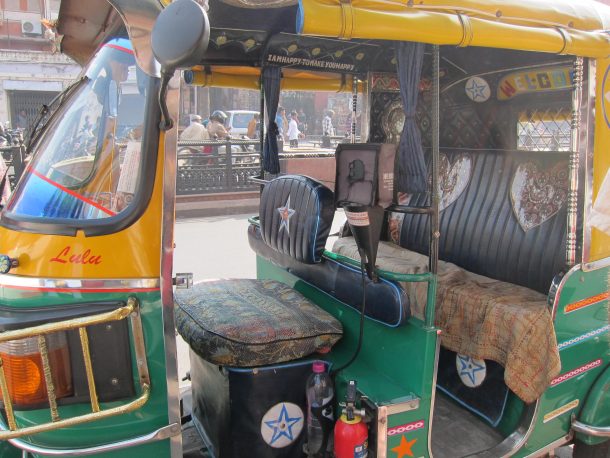
However, I was of-course confronted by the very opposite of handmade – lots of colourful mill-made textiles being used for all sorts of purposes.


While the exhibition is focused on handmade, it is important to remember that the majority of textiles today are made from mill-made fabrics. The introduction of factory made yarns from Europe began in the 1780s and by the 1820s it was being imported into India in large quantities. The first mills were built in Ahmedabad and Bombay in the 1850s but the biggest impact came in the 1950s when there was a post-Independence drive to industrialize textile production.
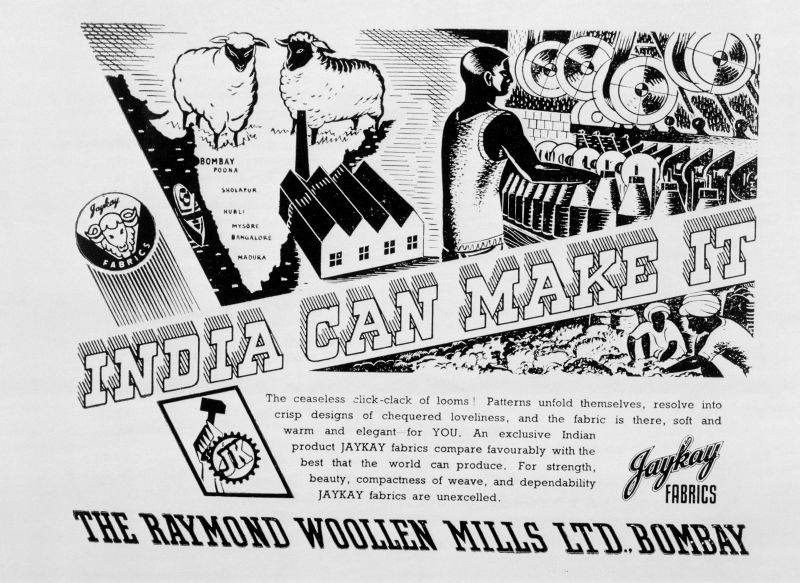

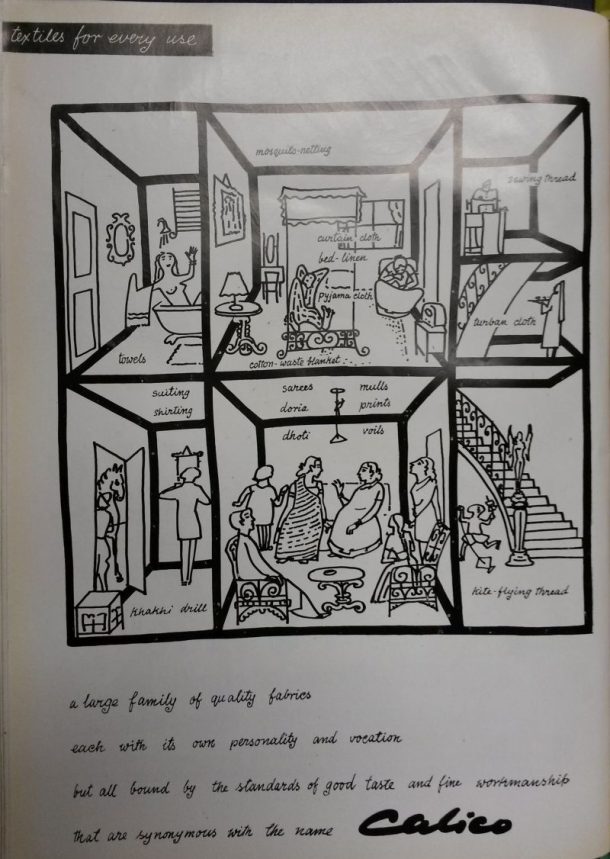
These wonderful advertisements of the 1950s show how textile production was an important element in the desire to modernise India. Mills had to clothe the nation and ‘provide textiles for every use’ as proclaimed in the Calico Mills advert. At the same time handloom production was also considered important for the preservation of national identity. Government initiatives to boost handloom production, revitalise it, adapt and innovate it for new urban markets went alongside the drive to industrialize textile production.


In these advertisements the mill-made saris were marketed as stylish and modern forms of dress.
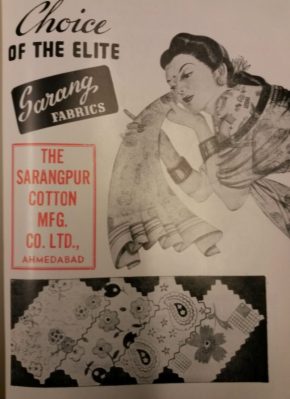

Tata textiles went one step further and showed a thoroughly contemporary woman in her western silhouette exuding calm and cool.
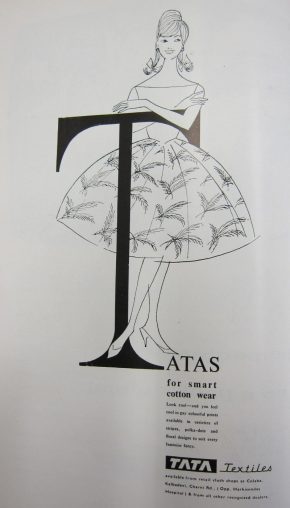
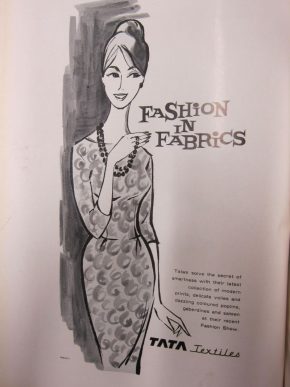
Today, the mill-made sari is one of the most common forms of clothing for older women. For the working women who sell vegetables, clean homes, tend crops on the farms and so on, these are the most practical garments, easily washable and more durable than handmade fabric. In Jaipur, it was interesting to see how woman still choose to wear prints that mimic handmade techniques that are specific to their region. Imitation tie-dye could be found everywhere.

There are different values attached to the wearing of saris, whether handmade or synthetic. I would recommend reading ‘The Sari’ by Mukulika Banerjee (Berg, 2003) in which she gives case studies of women from all levels of society on what the sari means to them. The exhibition will explore the way in which handloom and traditional textile techniques were adapted and innovated in the wake of industrialization.

Dear Divia,
I would like some information on the materials used for saris in the late 1900s and early 1920s, the types of blouses and the embroidery styles used during this period. Also, are there any reliable websites with such information/images?
Many thanks,
Nalisha Ladharam
I would like to get information about Tipu’s tent from the Powis castle which I believe you would be displaying the the Fabric of India show at the V and A. I am an artist and am trying to weave together the power and fall in contemporary India using the myth of Tipu as the leitmotif.
Thanks
Sharmila Samant
Dear Nalisha,
There is very little information on this early period so it is great that you are researching it. Meher Castelino in her book entitled ‘Fashion Kaleidoscope’ has a brief note on that period in which she mentions that saris were made of Japanese georgettes or Chinese silks and the blouses were long and covered. I would suggest doing some research in photographic archives to locate images of the period and also looking at literature of the period.
Dear Sharmila,
We’ll respond to you via your email address.
Dear Divya, Good information. Sarees in South during the 1900s were pure cotton ones and silk from Varanasi, Kanjeevaram, Madurai and Arni silk. Wedding sarees were all bought from Benares. Silk made from Banana fibres was worn by widows. Chinnalapattu not pure silk but a mix also proved popular. Mettur Mul, Salem weaves were also worn. It was nine yards. I have a wonderful stack of pattern books of 50s, the blouse styles featured can match that by any designer today:):). I am passionate about Indian handicrafts especially textiles (woven, embroidered or dyed) and write on it extensively.
Hey Divia Thanks for your information. Everything has been changed from past to present in dressing sense, but Rajasthan is the place where traditional dresses are still alive. Most of the traditional sarees from store http://www.kalkifashion.com goes to these place.
Great post, thanks for sharing with us.
I think cotton fabric is the best option for daily use, as it is very comfortable to wear.
Hi
Divya
Thanks for your information.
Sarees most of the traditional outfits .
Tahnk for sharing this post.
Really nice post, i’m a fashion blogger from india.
Nowadays indian ethnic wear is gaining popularity in western countries also especially Salwar Kameez, Wedding Lehenga Choli And Kurtis.
We have some interesting metrics to share, being manufacturer of salwar kameez materials. Handloom cloth production has marginally increased year on year. Production in year 2008 was 6947 million square meters and in 2016 the product was 7203 million square meters.
As Indian E-Commerce is growing rapidly, most of the manufacturers started to sell salwar kameez and other products like nilkamal chairs online, and good thing about buying something online is that we can compare the prices in a single go from nayashopi and also you can apply coupons to avail discounts. Happy Shopping.
Hello Sharmila,
Surat is the biggest textile market in India. Thanks for sharing
surat is great textile market all in one market for ladies waer textile market
I have been checking out a few of your stories and i must say nice stuff. I will surely bookmark your website
Let me highlight to other clothing which is widely wore all around the globe. Just like Salwar Kameez, Kurtis is seen wore every 5th lady. This is comfortable to wear and many companies follow this as formal dress. Divi patel would love if you come down in future for some post related to kurtis. If you need images for same then you can take from https://textilecatalog.in/wholesale-kurtis
Wow Very Nice Post I really like This Post.Please share more post.
latest blouse designs
India has state Gujarat and there is city known Surat. Surat hub textile industries where customer all around the globe and make purchase wholesale Kurtis, Sarees and other women clothing. I suggest all blog reader to if you would like grab some images or want to look what women clothing you get in Surat city then definitely visit https://f3fashion.com/kurti
Thank You V&A Your is quite Informative Regarding Textile Mills Development in India.
Wow Very Nice Post I really like This Post.Please share more post.
thank you for describing our country so well and showing its beauty. and hope you had a great time in india.
The fashion industry is a future-thinking industry because clothes are one of the necessities that people require. Fashionistas don’t mind showcasing their beauty in public while they’re at it. Your new designs trends Lace Tights under Boyfriend. You can also check Minu Fashion . Indian sarees are so popular that they complement every woman’s body type and level of adaptation. Sarees are the one outfit that will offer the most diversity and design when it comes to embroidery
Nice I have read lot of articles and said this is what I am looking for. What an informative information you have written, I like the way you express. Your sense of fashion is great and I love to share it with my friends.
I am from india . I can relate this. How ricksha wala use handloom textile.
such a great information of a blog.
Greet job , I love to wear saree and you are looking for wedding wear saree so here is a best platform for you.
hey Divia Patel
This is really impressing and accurate information that first mill was establised in Gujarat..
solitaire diamond ring in white gold, rose gold and yellow gold clour is aviable in this size